1981 French Grand Prix race report
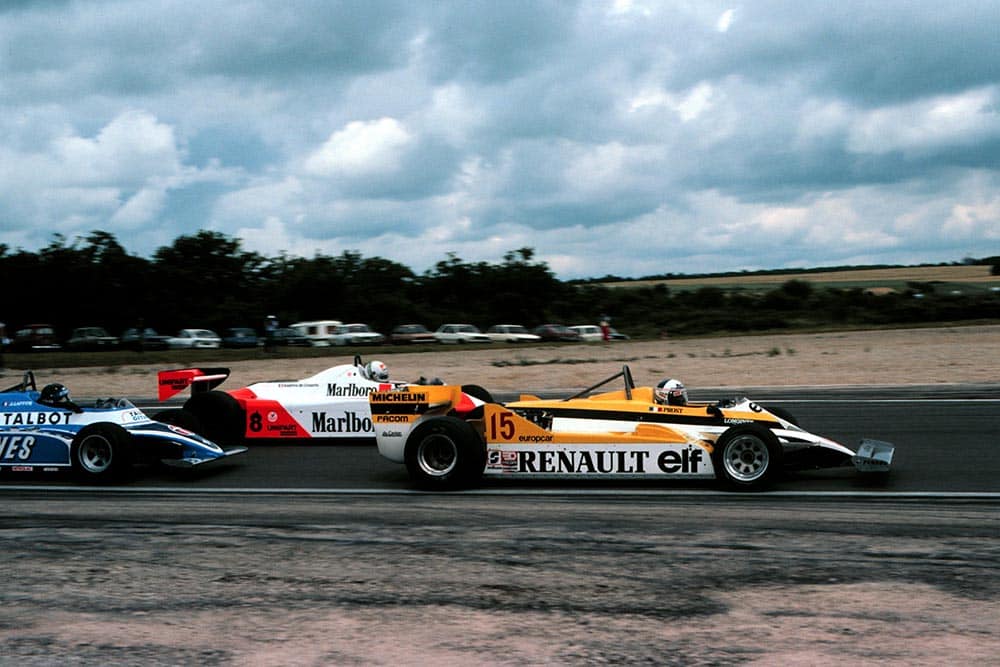
Renault's Alain Prost laps Andre de Cesaris on his way to a debut win
Motorsport Images
Inconclusive
Dijon-Prenois, July 5th
The most important aspect of the 1981 French Grand Prix was that it saw the return of the Goodyear Tyre Company to Formula One. It will be recalled that they withdrew entirely last winter during the fracas between Bernie Ecclestone and the Formula One constructors and officialdom. Thanks to the support of Michelin, who agreed to supply everyone with tyres for a limited time, Grand Prix racing got under way this year with everyone on a standard production racing tyre, apart from the Toleman-Hart team who had a contract with Pirelli. Immediately after the Spanish GP it was announced that Goodyear would be back, but their support initially would be limited to two top teams not on a long-term contract with Michelin.
That meant Williams and Brabham, so clearly Goodyear were looking for instant success and were coming back to win, not to be philanthropic. Naturally enough Michelin responded by saying that from now on tyres would be a serious matter and development work would only be for their long-contract teams, principally Renault, Ferrari, Alfa Romeo and Talbot. So, before practice began for the French GP on the little Dijon-Prenois circuit there was quite a lot of “wheeling and dealing” on the tyre front. Goodyear were adamant, tyres only for Williams and Brabham. Michelin were persuaded to help out Lotus, McLaren and Tyrrell but the rest had to do what they could.
March and Theodore agreed to buy the new Avons, Ensign found some old 1980 Goodyears in their stores and the rest had to buy the standard production racing Michelin as used by everyone earlier in the season. When everyone was on these production Michelin racing tyres it was all right, but with the favoured teams on special racing tyres and the Goodyear teams on the best that Akron could supply, the rest might just as well have been on British Bergounogne or Kelly Springfields. Hardest hit were the Arrows team for Patrese is well able to make use of good tyres, so was handicapped badly; their second runner probably did not notice much difference, as would other slow runners.
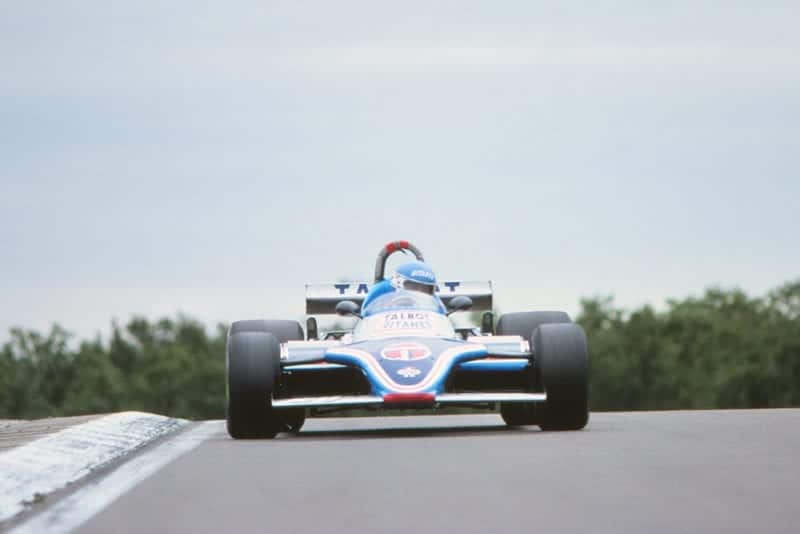
Patrick Tambay qualified 16th in his first race for Ligier
Motorsport Images
The Williams and Brabham teams had a lot of work to do in resetting their cars to get the best out of the new Goodyear tyres and in other pits there was also a lot to do because of driver changes. In the Talbot team Jabouille had retired gracefully and Patrick Tambay had taken his place and Marc Surer had taken over the Theodore. The Osella team could not find a second driver as their regular one, Angel Miguel Guerra was still convalescing and Georgia Francia was otherwise engaged, so they officially withdrew their second car. The McLaren team had a brand new MP4 to try out, Renault were wound up tight to do well in their home Grand Prix and Talbot were equally conscious of the importance of the event. Ferrari had been testing at the circuit earlier and seemed resigned to the fact that their cars did not handle well on the fast corners, so even their horsepower was not going to overcome this.
Qualifying
Friday morning saw the rain pouring down relentlessly so that the hour and a half normally used for testing, prior to the qualifying hour in the afternoon, was a virtual dead-loss. Although the rain stopped not many people were able to learn much. The Toleman-Hart team have enough troubles at the best of times, but the morning saw Brian Henton lying on his back and groaning with a severe attack of food-poisoning, while Warwick was in trouble with a faulty pressure release valve on the turbo system which left him with sky-high boost and he had to shut off before the engine blew apart.
The afternoon was dry but cold and windy and qualifying had not been running for long before more rain appeared, but luckily it did not develop and with the high wind the track soon dried. Alan Jones was having to use his spare car as his regular one had gearbox trouble and Piquet had to stop using the spare Brabham as it suffered a brake fluid leak, so he had to use his race-car. Add to all this the nonsensical ground-clearance checks at the exit and entrance to the pit lane and it’s a wonder that anyone got anything useful done. The Williams team were taking longer to adjust to the Goodyear tyres than the Brabham team, though they had both tested at Silverstone the previous week, and having no tyre problems on good Michelins the McLaren team made the most of the situation and Watson was fastest of the afternoon with MP4/2, his usual car, having tried out the new one in the morning. He was followed by the two Renaults and the two Ferraris, all on Michelin tyres best suited to the occasion, but it was an artificial situation for Jones, Reutemann and Piquet should certainly have been amongst them and probably Patrese as well. Down at the back of the field Warwick was giving the Toleman team some encouragement, being ahead of Borgudd (ATS), Salazar (Ensign) and Surer (Theodore). Henton did a few laps but was still feeling very rough.
Although it was not raining on Saturday it was very cool and very grey, with a strong wind blowing up the long straight, but at least conditions were stable and allowed some reasonable testing and experimenting to be done, the Goodyear teams adapting to cross-ply tyres after half a season on radials. For a change the Renault team were having few problems and were very fast on the main straight, over 200 m.p.h. being spoken of by some rather suspect timing, but certainly they were up around 185 m.p.h. Mansell had to abandon his Lotus 87 when a fuel injector pipe broke and caused a minor fire, though marshals swamped the whole car with fire extinguisher which gave the mechanics a lot of work to clean it all up.
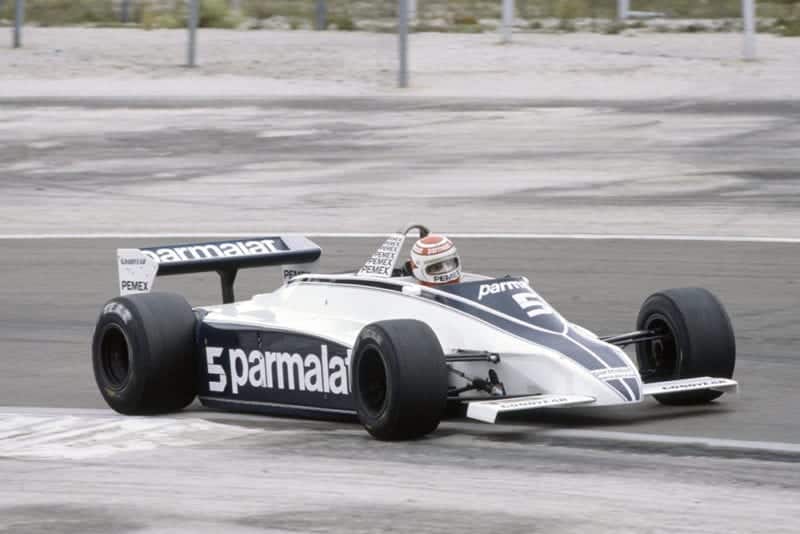
Nelson Piquet started the 4th on the grid for Brabham
Motorsport Images
Then the red flag came out and put a stop to practice. Villeneuve had gone off into the catch-fences on the very fast downhill sweep of the last bend before the main straight, through trying too hard and overcooking it. He walked back to the pits but a break-down was needed for the Ferrari (052); even so it was cleaned up and straightened out in time for the afternoon practice. Alan Jones was trying different things on his two cars, and generally preferring the spare car, which was number 11 that he crashed at Zolder earlier in the season, now all brand new after a total rebuild. Practice was resumed and Villeneuve went out in the spare Ferrari (050) and Mansell went out in the old Lotus 81/2 that the team had as spare.
Pironi added to the Ferrari troubles when he went up the straight trailing a great plume of smoke as a piston melted, which meant a panic engine change during the lunch hour, for Villeneuve had the spare car while his own was being straightened out. At the end of the pit lane the Toleman hopes were dashed when Warwick overdid things and hit the barriers, rumpling the monocoque of TG181B/03, but both he and Henton, who had now recovered, were keeping up with the tail-enders. In the Talbot team Laffite was flogging round and round, covering 51 laps during the morning, but while he was with the front-runners he was only just hanging on, and Tambay was down in mid-field still learning his way along with the Matra V12 engine, but enjoying every minute of it.
Due to the delay in the morning the final hour for qualifying did not start until 1.20 p.m. instead of 1 p.m. and it was still cool and grey, but staying dry. The Ferrari mechanics got Villeneuve’s car ready in time but Pironi’s was still being worked on so he took over the spare car (050). Mansell’s Lotus 87 was made ready and Watson was sticking to MP4/2. Work was going on to try and straighten out Warwick’s Toleman, but it was a forlorn task and Jones was trying 15″ diameter Goodyears on the front of his spare car, as against the normal 13″ diameter front tyres.
Arnoux was setting a cracking pace with his Renault RE33, completely happy with the performance and the handling, but Watson was equally happy with his McLaren MP4 and he was vying for pole position with the French team, for Prost was equally fast. In fact Prost equalled Watson’s best time, which put him third overall. As Watson recorded the time first, the order was Renault, McLaren, Renault, with Arnoux well ahead. Clearly the Brabham team were getting to grips with the new Goodyear tyres and Piquet was fourth fastest, behind the three Michelin-shod cars, but what was more important was that he was on tyres that would last the 80 laps of the race, whereas the Michelin runners were on short-life tyres especially for qualifying.
Pironi eventually got his own car back (053) with a new engine installed, but neither he nor Villeneuve could do better than mid-field times, in amongst the Alfa Romeos of Andretti and Giacomelli. Hopes were rising in the Toleman team for nearing the end of the timed hour Henton was in twenty-fourth place, the last one on the grid, but then in the final few minutes the Fittipaldi team got “Chico” Serra out in their spare car, after his own had wrecked its engine, and he just scraped onto the grid in twenty-fourth place, while Siegfried Stohr pipped Henton by four-hundredths of second, to become the first non-qualifier. That the McLaren MP4 was going well and was very suited to the circuit was evidenced not only by Watson’s stormy second place on the grid, but also by de Cesaris claiming fifth place, ahead of Laffite and Reutemann.
Race
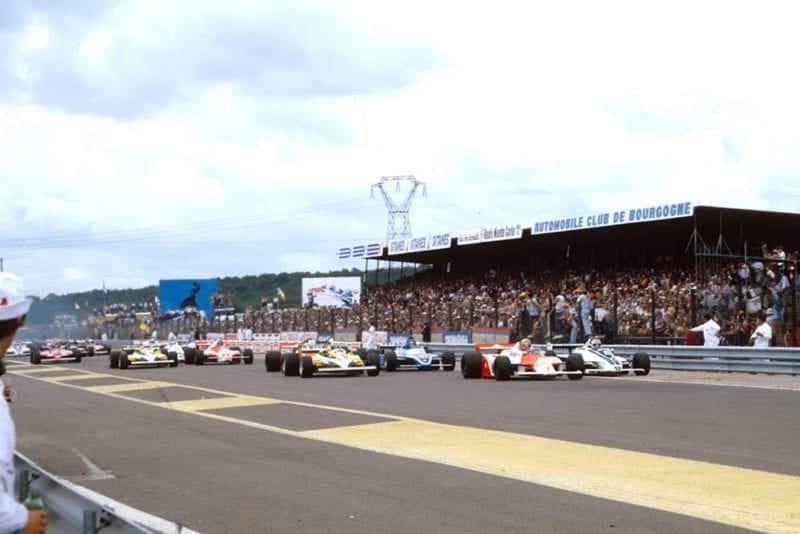
John Watson vies with Nelson Piquet for the lead at the start
Motorsport Images
Practice had been anything but clear-cut so the starting grid did not really reflect the true situation as far as race fortunes went, and during the morning warm-up on Sunday, when everyone was running in full race trim, which is to say with full tanks and on tyres that would last the 80 laps, a different picture emerged. Both Williams cars and both Brabham cars were faster than all the Michelin runners, of which Arnoux was the quickest but only in fifth place. The field of 24 cars was reduced to 23 before the end of the warm-up when Serra crashed his Fittipaldi too badly for it to be repaired on the spot and the teams’s spare car had a duff engine so that was that. Starting with this season, no reserve drivers are allowed any more so the grid was going to be one short.
Every time there was a lull in the Formula One activities a paddock gate was opened and a swarm of racing cars from a lesser category pounded round the circuit, these being for Renault 5, Alfa-Sud, Formula 3, Renault 5 Turbo, and Production cars and at midday when there was a pause for breath a great concourse of vintage, PVT and post-war Alfa Romeos paraded round the circuit, among them Baron de Graffenried in a Tipo 159, Moroni in the factory P2 and Lurani in his Targa Florio car. The 159 could be heard all round the circuit and sounded glorious.
Although the sun was shining when the cars left the pit lane to go round to the assembly grid, it was not very warm and grey clouds were all around. Jones had elected to race his spare car (No. 11) as it felt better on the fast corners; the Ferraris were running very low boost-pressure and there was an air of confidence in the Renault pits, but most people had their eye on Piquet who was lining his Brabham up behind Watson on the left of the grid, with the two Renaults one behind the other on the right-hand side. With very little fuss Arnoux led the field on an orderly parade lap and back to the starting grid.
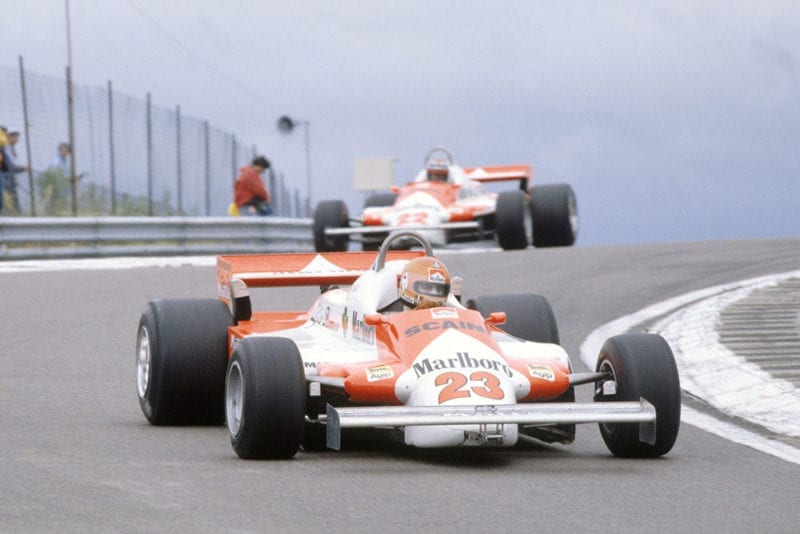
Bruno Giacomelli leads Mario Andretti (both Alfa Romeo 179B). They finished in 15th and 8th position respectively.
Motorsport Images
The starter pressed the button to put the red light on, the green being due between 4 and 7 seconds later, but something was wrong with the electrics and the green light came on with the red, they both flickered and without hesitating the starter hit the green button, which cancelled the red. Poor Arnoux was bewildered by it all and muffed his start, but Piquet was off like a flash, swerving round Watson and into the lead. From eleventh place Villeneuve shot down the outside and into fifth place! We all wonder how he does it and he says he goes when the red light goes out, not when the green comes on, but you would think he was wired in to the filament in the red bulb. Many of the drivers were caught out by the erratic light signals, among them Alan Jones, and in the crowding away from the grid he hit Andretti’s Alfa Romeo with a front wheel and bent a steering tie-rod.
By the end of the first lap Piquet was already well away from Watson but Prost was closing on the McLaren. In fourth place was de Cesaris, having kept out of trouble on the opening lap, Villeneuve was still fifth, Laffite sixth, Andretti seventh, Reutemann eighth and Arnoux a furious ninth. Jones was finding his steering a bit odd and at the end of the third lap he was into the pits to have a new tie-rod fitted between the right-hand steering arm and the steering rack. Meanwhile Piquet was streaking away from everyone and Prost overtook Watson on lap 3 and instantly pulled away from the McLaren. There were no changes further down the field and, in fact, they were drawn out into a procession, apart from Hector Rebaque who was down in fifteenth place, but picking off the mid-field runners one by one.
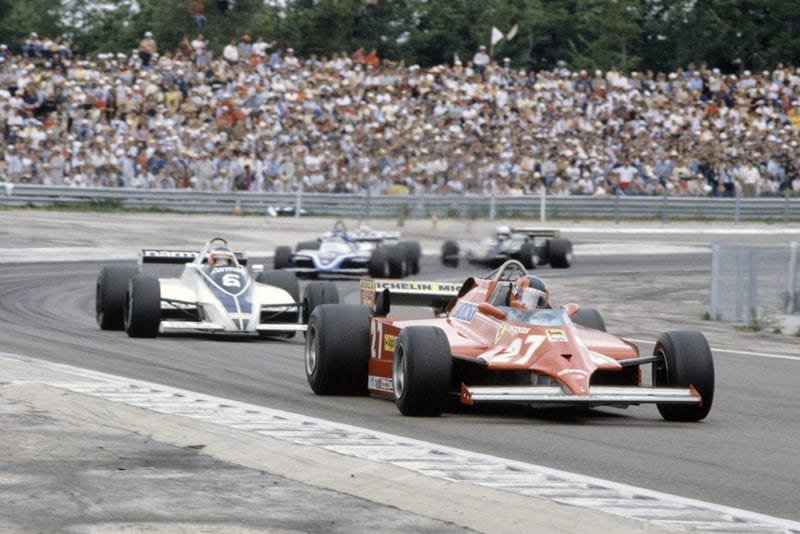
Gilles Villeneuve leads Hector Rebaque
Motorsport Images
First Tambay, then Giacomelli, then Mansell, then Andretti who had dropped back, then de Angelis; it was the only bright spot to a rather dull procession. Alan Jones had rejoined the race but he was three laps down and he was now running between his team-mate Reutemann and Arnoux, who were fourth and fifth respectively, the Renault driver having got past Villeneuve on lap 7. Reutemann was closing slowly on Watson, but not quick enough for Jones and on lap 15 the two Williams cars took the long right-hander at the end of the main straight side-by-side and rubbing tyres! Just behind them Laffite did the same to de Cesaris in a do-or-die effort to get past, which succeeded. By this time the Ensign had disappeared with a suspension failure and the lone Fittipaldi had also gone with a broken rear end that was letting the rear wheels steer as well as the fronts.
At 20 laps Piquet was so far ahead he was in a race of his own and equally Prost was a long ahead of Watson. In fourth place Reutemann was falling back as his left front tyre had come up in a blister and he was going gently on the right-hand corners and trying to make up time on the left-handers. Arnoux was still a fair way back in fifth place and Villeneuve was leading Laffite and de Cesaris. After a gap came Pironi being pressed by Rebaque, followed by de Angelis and trailing along behind came Andretti, Mansell, Giacomelli, Tambay, Patrese and Surer with Daly, Cheever and Alboreto already lapped by the leader. Jones was into the pits again to change his front tyres, to try and improve the handling and a couple of laps later he was back again as he felt a front wheel nut was loose. It wasn’t so he rejoined the race but was now four laps behind and right out of the running.
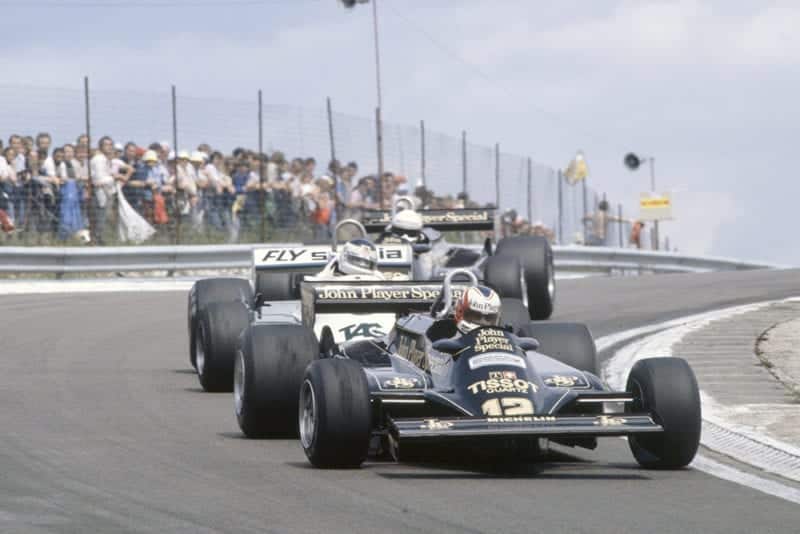
Lotus’ Nigel Mansell on the way to finishing 7th
Motorsport Images
The race now became rather uninspired, the only spark being Rebaque still passing people down in mid-field, claiming de Cesaris on lap 28 and sitting it out wheel-to-wheel with Laffite on lap 30, which now put him in seventh position. Piquet was now in a spot of trouble for his throttle slides were not shutting instantly when he took his foot off the accelerator pedal, which did not cause concern when he was alone on the track, but made it tricky when he was lapping slower cars. In second place Prost was also in trouble as he could not select fourth gear, but Watson was all right in third place, though Reutemann had lost fourth place to Arnoux and was still nursing his blistered left-front tyre. Villeneuve’s sixth place disappeared when his engine cut dead on lap 42, with some sort of electrical failure, so this promoted the hard-working Rebaque up into a worthy sixth place.
Piquet’s hesitancy in passing slower cars allowed Prost to close up on him, but not dangerously so, and equally Prost’s lack of fourth gear allowed Watson to close up, while Reutemann had repassed Arnoux. Down at the back of the field Surer was having a spirited dice in the Avon-shod Theodore, racing wheel-to-wheel with Giacomelli’s works Alfa Romeo and getting the better of it.
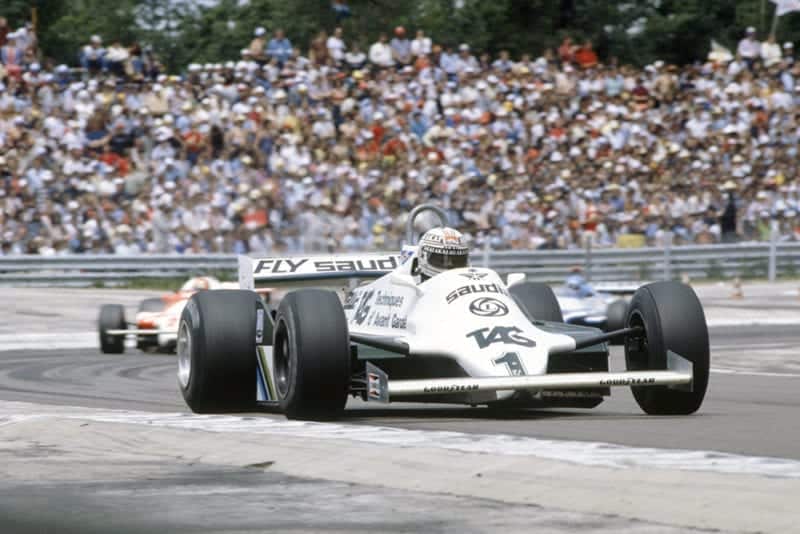
Alan Jones in a Williams FW07C-Ford Cosworth.
Motorsport Images
At 50 laps Piquet had finally lapped his Mexican team-mate, but had Alan Jones just behind, though four laps down, and Jonesey was all for going faster than the leading Brabham wanted to, which was a bit unnerving for the little Brazilian, but he did not let it worry him. With 30 laps still to run victory seemed pretty,assured, but there was a Joker in the pack. On lap 54 rain spots began to fall as a big black cloud approached the far end of the circuit and a deluge moved relentlessly up the long straight. It took about three minutes to arrive and by lap 57 the straight was awash and Piquet completed his fifty-eighth lap at a crawl, the car immersed in spray, to be greeted by the red flag, with black ones all round the circuit, which meant the race was being stopped.
He, and those on the same lap with him, pulled in at the end of their fifty-ninth lap as the rain virtually obliterated everything for a few minutes; then it was gone, the sun came out and people and the track dried instantly. But it was too late, the organisers had stopped the race in a bit of a panic. The rules say that if 75% of the distance has been covered the race can be considered finished, but less than that means that the remaining laps must be run when conditions allow and the overall result will be calculated from the additions of times for the two parts. Two more laps would have seen the 75% and victory to Piquet and his Brabham, but that was not to be, a further 22 laps had to be run with a restart with the cars lined up in the order they had finished the first part. As the rain had come down de Cesaris had gone into the pits expecting to change to rain tyres, and was there when the race was stopped which dropped him from eighth to fourteenth place. The result of the first part was taken at the end of 58 laps.
In a matter of minutes the rain had gone and within 30 minutes everything was drying rapidly. Before the restart the Renault mechanics cured the gearbox trouble on Prost’s car, the Brabham mechanics cured the sticking throttle slides on Piquet’s car, Reutemann’s blistered tyre was changed and the leading Michelin runners were fitted out with a softer compound set of tyres that would nicely last about 25 laps. There had been nineteen cars classified in the first part and they lined up in the order Piquet (Brabham), Prost (Renault), Watson (McLaren), Reutemann (Williams), Arnoux (Renault), Rebaque (Brabham), Laffite (Talbot), de Angelis (Lotus), Pironi (Ferrari), Mansell (Lotus), Andretti (Alfa Romeo), Surer (Theodore), Giacomelli (Alfa Romeo), de Cesaris (McLaren), Patrese (Arrows), Cheever (Tyrrell), Alboreto (Tyrrell), Jones (Williams) and Daly (March). The restart was given at 3.05 p.m. with the cars lined up on the grid in staggered pairs, but it was all over before the green light came on. The Goodyear runners were committed to relatively hard 80 lap tyres, while the Michelin men were on soft “sprint” tyres, the Akron firm having nothing suitable for such a short race, while the French firm had something for every occasion, and this was one of them. From the start Prost, Watson, Arnoux and Pironi surged away and Piquet strove valiantly to hang on to third place. Watson actually tried to pass Prost on the opening lap and nearly got away with it, but ran wide and dropped back. The 22 laps were a rather pointless formality and poor Nelson Piquet had to watch victory slip from his grasp as Prost disappeared into the distance and likewise Watson into second place. He could not keep up with Arnoux or Pironi, but had sufficient time in hand over them from the first 58 laps that he was still ahead on aggregate times. If anyone passed anyone during the 22 laps it was not noticeable and the order at the end of part two was Prost, Watson, Arnoux, Pironi, Piquet, de Cesaris, Andretti, Jones, Mansell, de Angelis, Rebaque, Cheever, Surer, Patrese, Alboreto, Reutemann and Giacomelli.
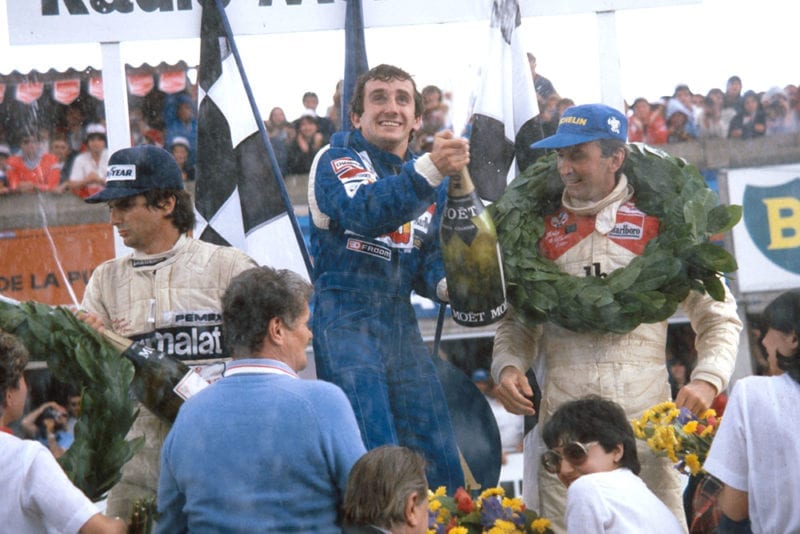
Winner Alain Prost, 2nd placed John Watson and Nelson Piquet in 3rd position on the podium.
Motorsport Images
On the opening lap Laffite had hit the back of Reutemann’s car, and deranged the front end of the Talbot, and Daly had pulled out after seven laps when his engine began to seize. From fifth place in the opening laps Reutemann had gradually fallen right to the back as his engine developed a chronic misfire with all the symptoms of a drastic drop in fuel-pressure, rather like Jones had suffered at Monaco. Not a Williams year this one.
The very unsatisfactory results given below constitute the classification for the 1981 French Grand Prix, arrived at by adding the times taken by each driver for the 58 laps and for the 22 laps. – D.S.J.
